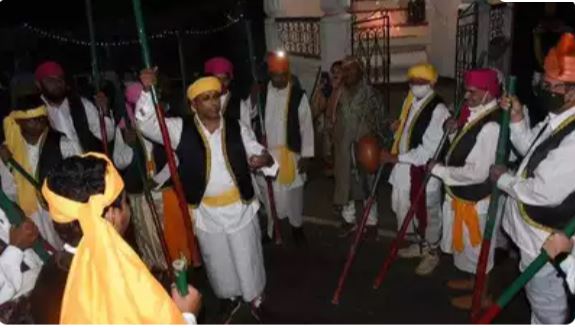By Dr Olav Albuquerque
WHEN a winter evening settles down in Chandor, on the last day of Carnaval as it is known in Goa, a troupe of men and a few women, go from house to house in Cavorim, clad in traditional dhoti, waistcoat and headgear, carrying a ghumot (drum) and a pestle. They visit the homes of the original Gaonkars, or land owners who were Kshatriyas, where they perform a traditional dance known as the “mussol khel” amidst rhythmic pounding of the pestle and singing in Konkani.
The men move in a circle, one step forward and one step backward, pounding the pestle on the ground, singing in lilting Konkani to the vibrant beat of the ghumot under the starlight and well past midnight. This mussol khel has been staged for nearly 800 years only in the two wards of Cotta and Cavorim in Chandor while it is not held at Guirdolim which is another ward of this village. This dance and festival is the only one of its kind in the world.
KSHTARIYA DESCENDANTS
What is fascinating is the troupe comprises the descendants of the Kshatriya who were converted to Catholicism and known as Chardos who can be loosely identified by the surnames of D’Silvas, Antaos, Fernandes, Pereiras, Gomes, D’Cruz, Furtados, et al. The mussol khel dance troupe visits these descendants of the Gaonkars of yore who are all Chardos. Perhaps a Y-chromosome test of these men may prove a common ancestry. But nobody has thought of that as yet.
The troupe gathers at the St Anthony’s copel (chapel) at midnight and bursts crackers to herald their arrival at a bungalow. This traditional mussol khel or the mussol dance has been staged uninterruptedly since the 1200s or perhaps even before that. There was a time before the early 1970s when electricity had not made its advent in Chandor and the mussol khel dance troupe would go from house to house, swinging kerosene lanterns and lamps while singing in tandem and performing the traditional dance.
The Mussol Khel troupe is welcomed in every Chardo house with eatables and cold drinks or something stronger to promote camaraderie. If there is a death in a family, a candle is put out on the verandah to signify the family is in mourning. The Mussol khel troupe will then say a Rosary for the departed soul and move onwards to the next house.
On the last day of Carnaval in February, 43 days after the Feast of the Three Kings which falls on January 6, has ended, on a Monday the Mussel troupe wends its way from house to house in the ward of Cotta. On Tuesday, another troupe, this time comprised of Cavorim residents gathers at the St Anthony’s copel and wends their way from house to house in Cavorim.
COMMEMORATED ROYALTY!
IT is said the dance made its way to Goa through the Kadamba dynasty which ruled at what is now known as Cotta between 980 AD and 1005 AD. Remnants of bricks and pottery can still be found here. But some old-timers in Chandor believe that this mussol khel dance was first performed to commemorate the victory of the Vijayanagar King Harihara over the Chola kings.
During the dance, the men wear a dhoti, jacket, pagdi, and ghungroo, and dancing anti-clockwise in a circle, they point the pestles towards the middle – moving one step back and one step in front to the thump-thump-thump of the pestle and the beating of the ghumot with the slapping of their feet on the ground.
The ghumot is a traditional musical instrument of Goa. It is an ancient form of percussion, and is more like an earthen pot with two openings – a narrow and broad one. The original ghumot was made using the skin of the monitor lizard. However, a different material is used today because monitor lizards are a protected species under the Wildlife Act.
HALF-BAKED POLITICIANS
TRAGICALLY, some half-baked politicians in Cavorim want to stop this mussol khel on the specious ground that it is discriminatory. They are ignorant of the fact that Article 29 (1) gives the right to citizens (which include minorities) to protect their art and culture, where they have a distinct script and language. Now, the words of the mussol khel can be written in traditional Romi Konkani which is spoken by the Catholic Chardo community.
Romi Konkani has a unique flavour of its own because its pronunciation, vocabulary and script are different from the Devanagari script. Devanagari is the script of the majority while Romi Konkani belongs to the minority. The words of the ancient mussol khel song have a traditional resonance and tempo which is impossible to capture in the Devanagari script.
There can be no doubt that the Gaonkars of yore were Kshatriyas who were converted to Catholicism. There is a misconception that the mussol khel dance is linked to caste but this is not the case because the troupe visits the homes of the descendants of the old Gaonkars. Every village in Goa has traditional occupations which were linked to the caste of the forefathers. Like it or not, this has been borrowed from our Hindu forefathers for whom caste was an endemic facet of life.
A motley set of politicians who have opposed this traditional mussol khel on the pernicious ground that it is opposed to the right to equality have got their facts wrong. It is a beautiful harvest dance where the pestle is used to pound the rice and evoke conviviality among the Gaonkars of yore, who are the ancestors of those who live in the village today. This is why the mussol khel must continue forever.

